Peugeot 508 RXH 2012 - RHD (UK, Australia) Owner's Guide
Manufacturer: PEUGEOT, Model Year: 2012, Model line: 508 RXH, Model: Peugeot 508 RXH 2012Pages: 304, PDF Size: 8.96 MB
Page 31 of 304
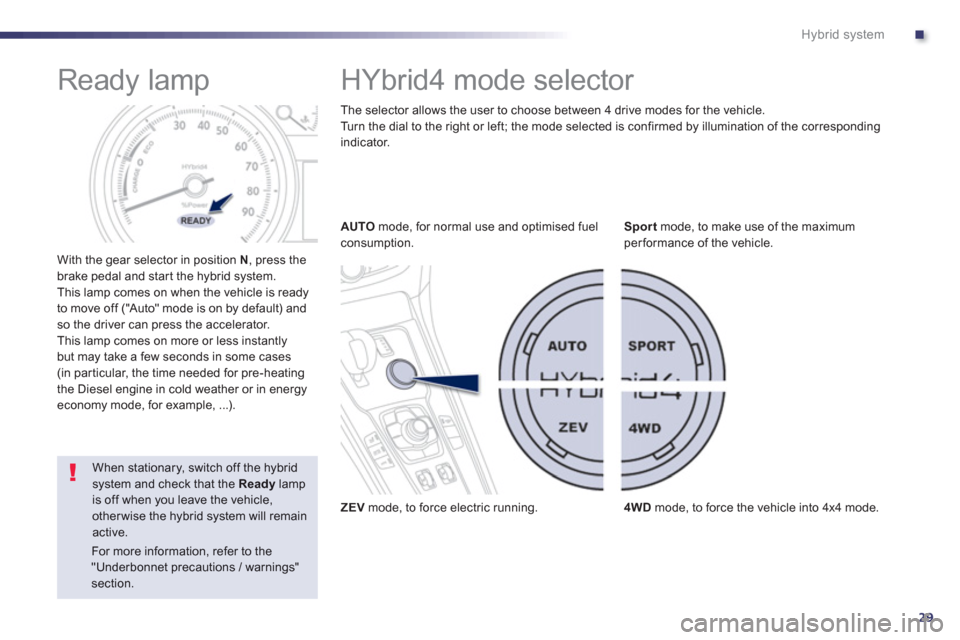
.
29
Hybrid system
Ready lamp
With the gear selector in position N, press the
brake pedal and star t the hybrid system.
This lamp comes on when the vehicle is read
y
to move off ("Auto" mode is on by default) andso the driver can press the accelerator.
This lamp comes on more or less instantlybut may take a few seconds in some cases (in par ticular, the time needed for pre-heating
the Diesel engine in cold weather or in energy economy mode, for example, ...).
HYbrid4 mode selector
AUTOmode, for normal use and optimised fuelconsumption.
ZEVmode, to force electric running.S
portmode, to make use of the maximum
performance of the vehicle.
4WDmode, to force the vehicle into 4x4 mode.
When stationary, switch off the hybridsystem and check that the Readylamp is off when you leave the vehicle,otherwise the hybrid system will remainactive. Th
e selector allows the user to choose between 4 drive modes for the vehicle.
Turn the dial to the right or left; the mode selected is confirmed by illumination of the corresponding indicator.
For more information, refer to the "Underbonnet precautions / warnings" section.
Page 32 of 304
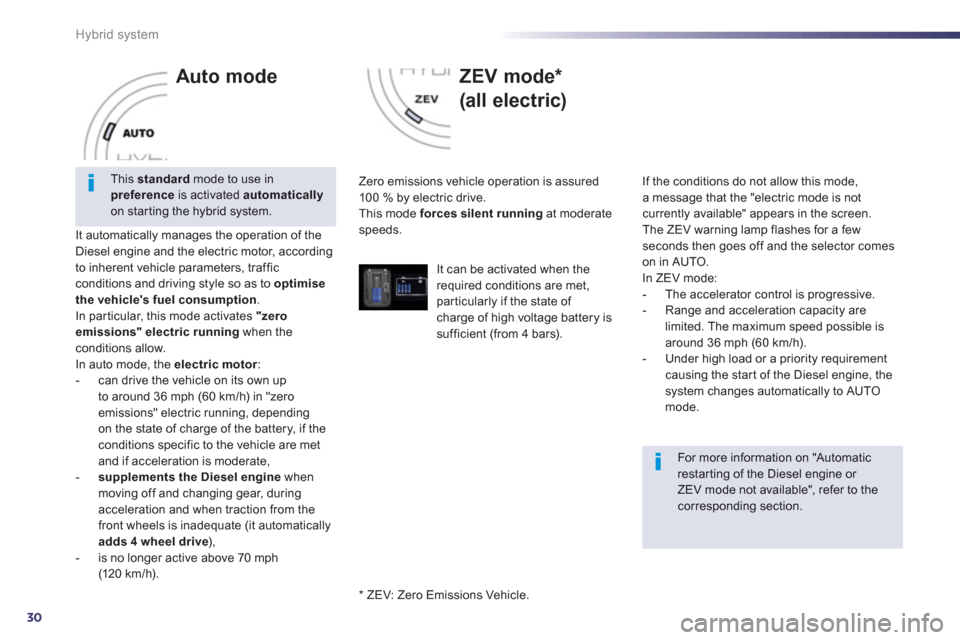
30
Hybrid system
Auto mode
It automatically manages the operation of the
Diesel engine and the electric motor, according
to inherent vehicle parameters, traffic
conditions and driving style so as to optimise
the vehicle's fuel consumption.In par ticular, this mode activates "zero emissions" electric runningwhen theconditions allow.
In auto mode, the electric motor
:
- can drive the vehicle on its own up
to around 36 mph
(60 km/h) in "zero
emissions" electric running, dependingon the state of charge of the battery, if the conditions specific to the vehicle are metand if acceleration is moderate, -supplements the Diesel enginewhen moving off and changing gear, during acceleration and when traction from thefront wheels is inadequate (it automaticallyadds4 wheel drive ),
- is no longer active above 70 mph (120 km / h).
ZEV mode *
(all electric)
Zero emissions vehicle operation is assured
10 0 % by electric drive.
This mode forces silent runningat moderatespeeds.
If the conditions do not allow this mode
,a message that the "electric mode is notcurrently available" appears in the screen.
The ZEV warning lamp flashes for a fewseconds then goes off and the selector comes
on in AUTO.
In ZEV mode:
- The accelerator control is progressive.
- Range and acceleration capacity are limited. The maximum speed possible is around 36 mph (60 km/h).
- Under high load or a priority requirement causing the star t of the Diesel engine, thesystem changes automatically to AUTO mode.
This standard
mode to use inpreferenceis activated automaticallyon star ting the hybrid system.
For more information on "Automaticrestarting of the Diesel engine or ZEV mode not available", refer to the corresponding section.
* ZEV: Z
ero Emissions Vehicle.
It can be activated when the
required conditions are met,
particularly if the state of charge of high voltage battery issufficient (from 4 bars).
Page 33 of 304
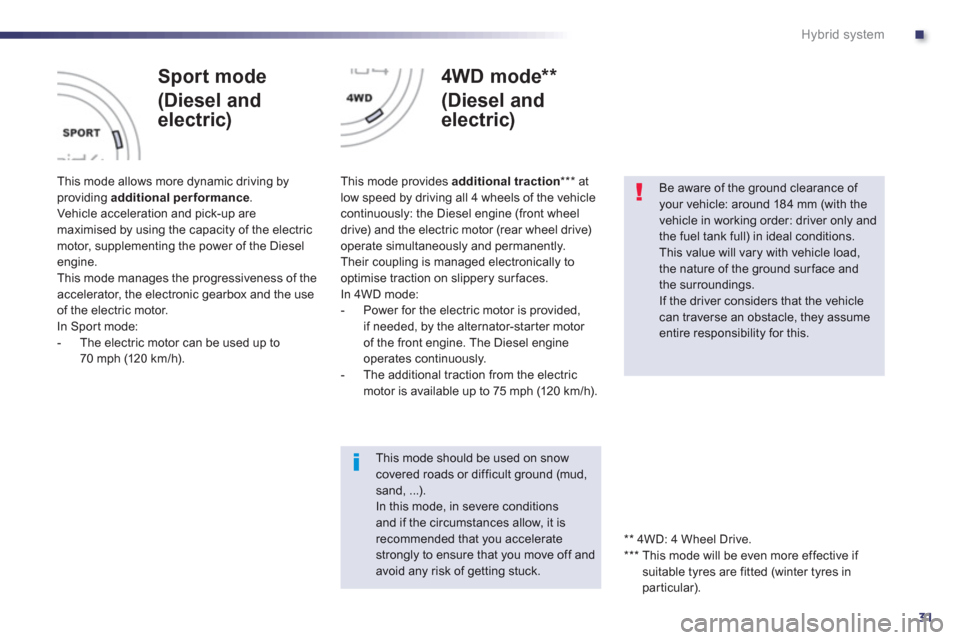
.
31
Hybrid system
Sport mode
(Diesel and
electric)
This mode allows more dynamic driving byproviding additional performance. Vehicle acceleration and pick-up aremaximised by using the capacity of the electricmotor, supplementing the power of the Dieselengine.
This mode manages the progressiveness of the
accelerator, the electronic gearbox and the useof the electric motor.
In Spor t mode:
-
The electric motor can be used up to
70 mph (120 km/h).
4WD mode **
(Diesel and
electric)
This mode provides additional traction*** at low speed by driving all 4 wheels of the vehiclecontinuously: the Diesel engine (front wheel
drive) and the electric motor (rear wheel drive)
operate simultaneously and permanently.
Their couplin
g is managed electronically to
optimise traction on slippery surfaces.
In 4WD mode:
- Power for the electric motor is provided,
if needed, b
y the alternator-star ter motor
of the front engine. The Diesel engine
operates continuously.
- The additional traction from the electric
motor is available up to 75 mph (120 km/h).
This mode should be used on snowcovered roads or difficult ground (mud, sand, ...). In this mode, in severe conditionsand if the circumstances allow, it is recommended that you acceleratestrongly to ensure that you move off andavoid any risk of getting stuck.
Be aware of the ground clearance of your vehicle: around 184 mm (with the vehicle in working order: driver only and
the fuel tank full) in ideal conditions. This value will vary with vehicle load,the nature of the ground surface and the surroundings.
If the driver considers that the vehiclecan traverse an obstacle, they assumeentire responsibility for this.
**
4WD: 4 Wheel Drive.
***
This mode will be even more effective if suitable tyres are fitted (winter tyres in
particular).
Page 34 of 304
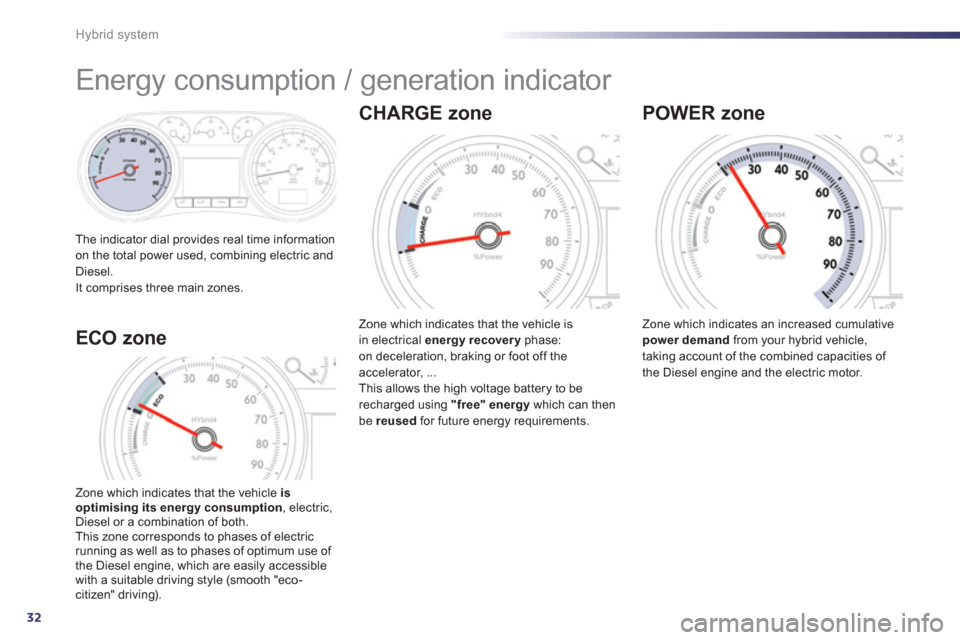
32
Hybrid system
Energy consumption / generation indicator
The indicator dial provides real time information
on the total power used, combining electric and
Di
esel.
It comprises three main zones.
CHARGE zone
Zone which indicates that the vehicle isin electrical energy recovery
phase:
on deceleration, braking or foot off the
accelerator, ...
This allows the high voltage battery to be recharged using "free" energy
which can thenbe reusedfor future energy requirements.
POWER zone
Zone which indicates an increased cumulative power demand
from your hybrid vehicle,
taking account of the combined capacities of
the Diesel engine and the electric motor.
Z
one which indicates that the vehicle is
optimising its energy consumption, electric,
Diesel or a combination of both.
This zone corresponds to phases of electric
running as well as to phases of optimum use of
the Diesel engine, which are easily accessible
with a suitable driving style (smooth "eco-citizen" driving).
ECO zone
Page 35 of 304
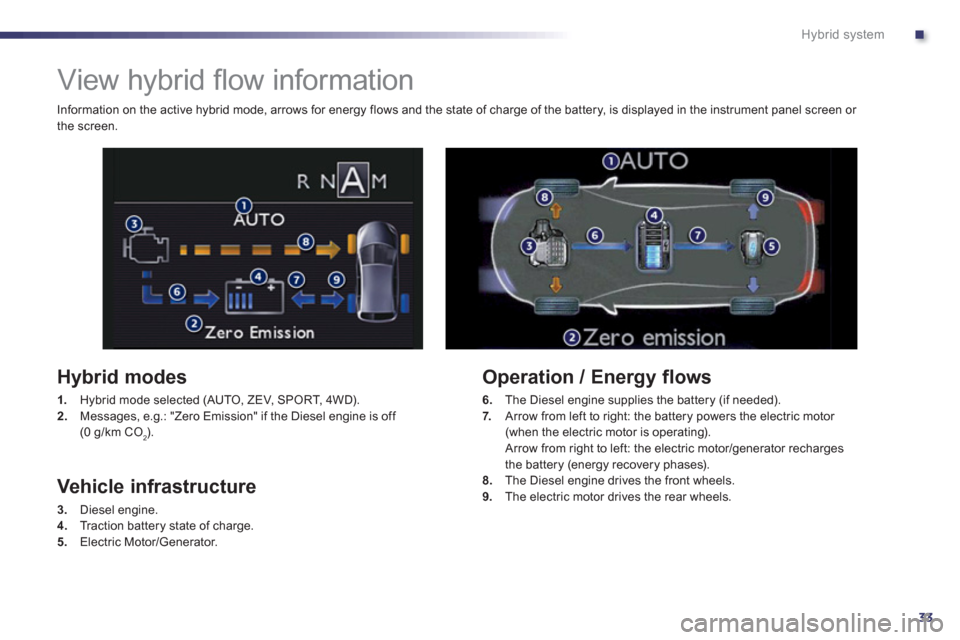
.
33
Hybrid system
View hybrid fl ow information
Hybrid modes
1.
Hybrid mode selected (AUTO, ZEV, SPORT, 4WD). 2.Messages, e.g.: "Zero Emission" if the Diesel engine is off (0 g/km CO2).
Vehicle infrastructure
3.Diesel engine.4.
Tr a c t i o n b a t t e ry state of charge.
5. Electric Motor/Generator.
Operation / Energy flows
6.
The Diesel engine supplies the battery (if needed).
7.Arrow from left to right: the battery powers the electric motor (when the electric motor is operating).
Arrow from right to left: the electric motor/generator recharges
the battery (energy recovery phases). 8. The Diesel engine drives the front wheels. 9.The electric motor drives the rear wheels. Information on the active h
ybrid mode, arrows for energy flows and the state of charge of the battery, is displayed in the instrument panel screen or
the screen.
Page 36 of 304
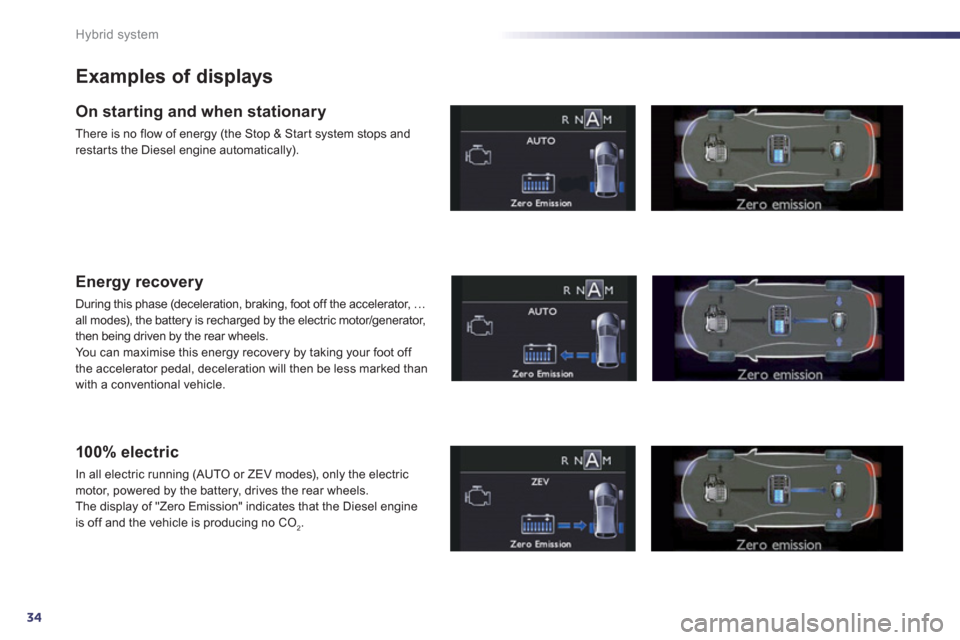
34
Hybrid system
Examples of displays
On starting and when stationary
There is no flow of energy (the Stop & Star t system stops and restar ts the Diesel engine automatically).
Energy recovery
During this phase (deceleration, braking, foot off the accelerator, … all modes), the battery is recharged by the electric motor/generator,
then being driven by the rear wheels.
You can maximise this ener
gy recovery by taking your foot off
the accelerator pedal, deceleration will then be less marked than
with
a conventional vehicle.
100% electric
In all electric running (AUTO or ZEV modes), only the electricmotor, powered by the battery, drives the rear wheels.
The display of "Zero Emission" indicates that the Diesel engine
is off and the vehicle is producing no CO2.
Page 37 of 304
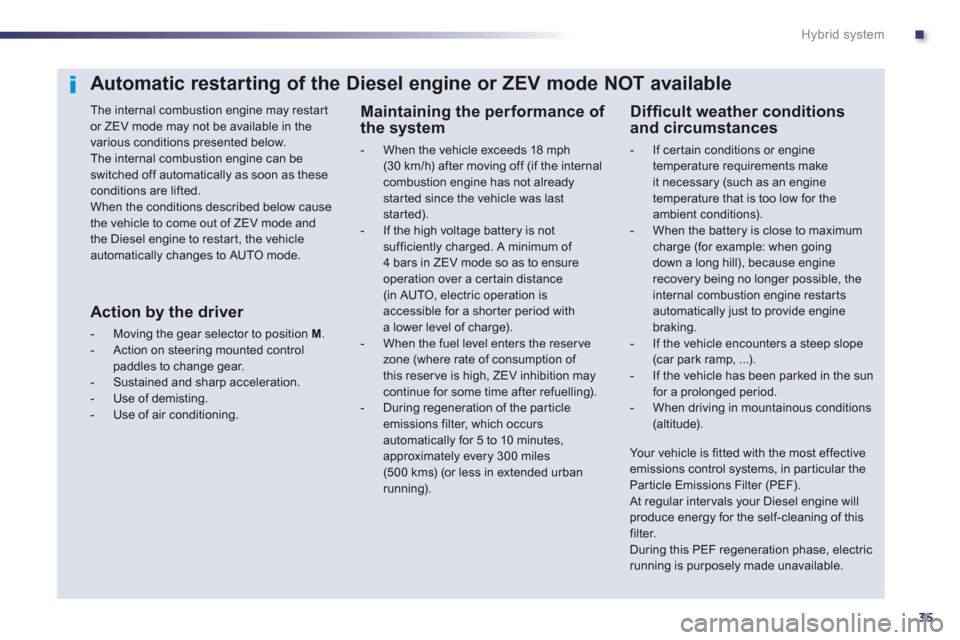
.
35
Hybrid system
Automatic restarting of the Diesel engine or ZEV mode NOT available
The internal combustion engine may restar t or ZEV mode may not be available in the various conditions presented below.
The internal combustion engine can be switched off automatically as soon as these conditions are lifted. When the conditions described below causethe vehicle to come out of ZEV mode and the Diesel engine to restar t, the vehicleautomatically changes to AUTO mode.
Diffi cult weather conditions and circumstances
- If certain conditions or engine
temperature requirements make it necessary (such as an enginetemperature that is too low for the ambient conditions). - When the battery is close to maximum charge (for example: when goingdown a long hill), because enginerecovery being no longer possible, theinternal combustion engine restarts automatically just to provide engine braking.- If the vehicle encounters a steep slope (car park ramp, ...).- If the vehicle has been parked in the sun for a prolonged period.- When driving in mountainous conditions (altitude).
Your vehicle is fitted with the most effectiveemissions control systems, in par ticular theParticle Emissions Filter (PEF). At regular intervals your Diesel engine will produce energy for the self-cleaning of this filter.During this PEF regeneration phase, electric running is purposely made unavailable.
Maintaining the performance of the system
- When the vehicle exceeds 18 mph
(30 km/h) after moving off (if the internal combustion engine has not alreadystarted since the vehicle was last started). - If the high voltage battery is notsufficiently charged. A minimum of 4 bars in ZEV mode so as to ensure operation over a cer tain distance (in AUTO, electric operation isaccessible for a shor ter period witha lower level of charge). - When the fuel level enters the reserve zone (where rate of consumption of this reserve is high, ZEV inhibition maycontinue for some time after refuelling).- During regeneration of the par ticle emissions filter, which occurs
automatically for 5 to 10 minutes, approximately every 300 miles(500 kms) (or less in extended urban running).
Action by the driver
- Moving the gear selector to position M.
- Action on steering mounted controlpaddles to change gear.
- Sustained and sharp acceleration.
- Use of demisting.
- Use of air conditioning.
Page 38 of 304
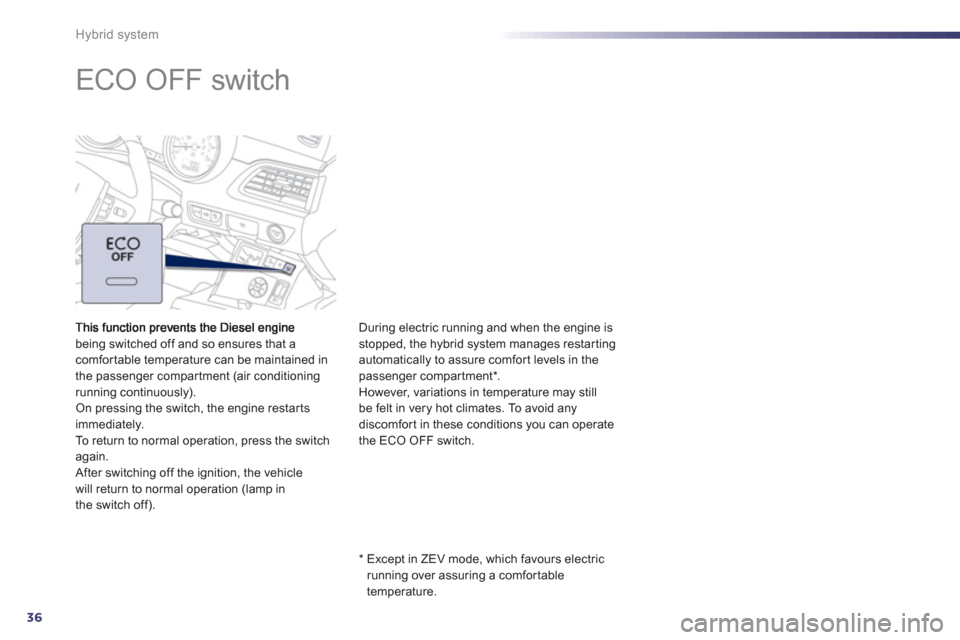
36
Hybrid system
ECO OFF switch
being switched off and so ensures that a comfor table temperature can be maintained in
the passenger compar tment (air conditioningrunning continuously).On pressing the switch, the engine restar ts
immediately.
To return to normal o
peration, press the switchagain.
After switching off the ignition, the vehicle
will return to normal operation (lamp in
the switch off).
*
Except in ZEV mode, which favours electric
running over assuring a comfortable
temperature.
Durin
g electric running and when the engine is
stopped, the hybrid system manages restarting
automatically to assure comfor t levels in the
passenger compartment * .
However, variations in temperature may still be felt in very hot climates. To avoid anydiscomfort in these conditions you can operate
the E
CO OFF switch.
Page 39 of 304
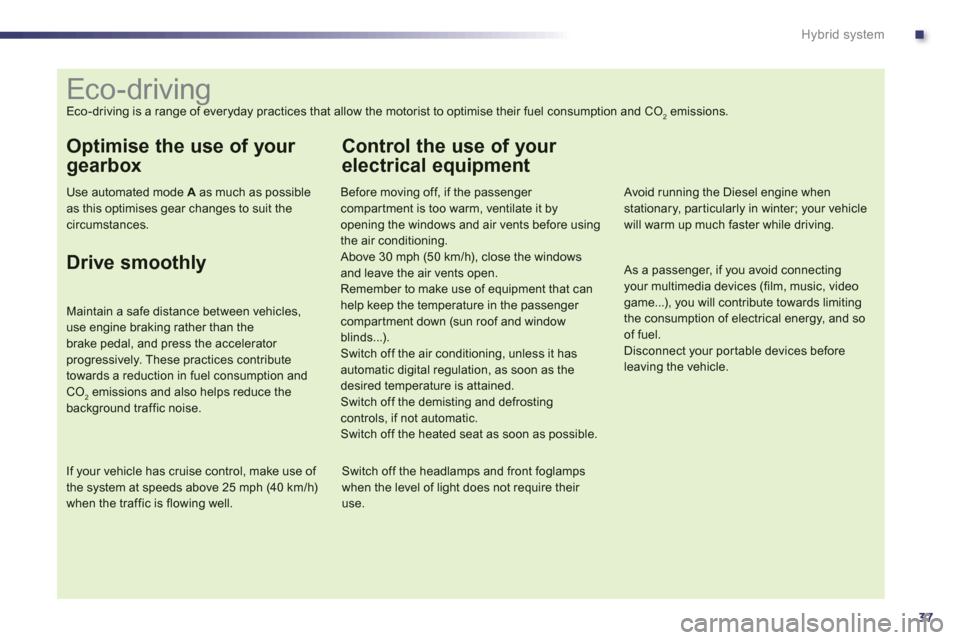
.
37
Hybrid system
Eco-driving
Eco-driving is a range of everyday practices that allow the motorist to optimise their fuel consumption and CO2 emissions.
Optimise the use of your
gearbox
Use automated mode Aas much as possible as this optimises gear changes to suit the
circumstances.
Drive smoothly
Maintain a safe distance between vehicles, use engine braking rather than the brake pedal, and press the accelerator progressively. These practices contribute towards a reduction in fuel consumption and CO2 emissions and also helps reduce thebackground traffic noise.
If your vehicle has cruise control, make use of the system at speeds above 25 mph (40 km/h) when the traffic is flowing well.
Control the use of your
electrical equipment
Before moving off, if the passenger compartment is too warm, ventilate it byopening the windows and air vents before using the air conditioning.
Above 30 mph (50 km/h), close the windowsand leave the air vents open. Remember to make use of equipment that canhelp keep the temperature in the passenger compartment down (sun roof and window blinds...).Switch off the air conditioning, unless it has automatic digital regulation, as soon as the desired temperature is attained.Switch off the demisting and defrosting controls, if not automatic.
Switch off the heated seat as soon as possible.
Switch off the headlamps and front foglampswhen the level of light does not require their use.
Avoid running the Diesel engine when stationary, par ticularly in winter; your vehiclewill warm up much faster while driving.
As a passenger, if you avoid connecting your multimedia devices (film, music, video game...), you will contribute towards limitingthe consumption of electrical energy, and soof fuel.
Disconnect your por table devices beforeleaving the vehicle.
Page 40 of 304
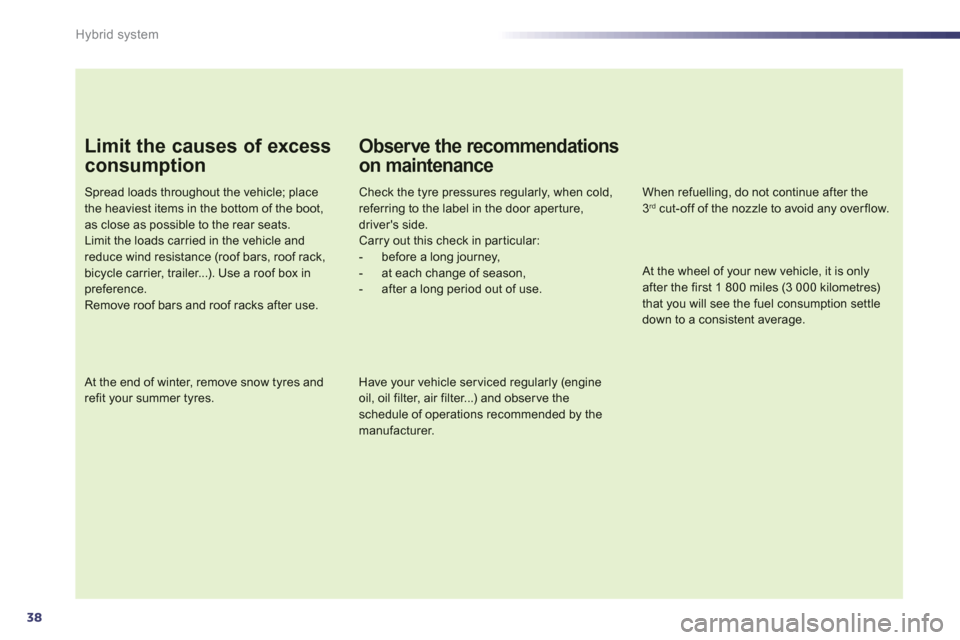
38
Hybrid system
Limit the causes of excess
consumption
Spread loads throughout the vehicle; placethe heaviest items in the bottom of the boot,as close as possible to the rear seats.Limit the loads carried in the vehicle andreduce wind resistance (roof bars, roof rack,bicycle carrier, trailer...). Use a roof box in preference.Remove roof bars and roof racks after use.
At the end of winter, remove snow tyres and refit your summer tyres.
Observe the recommendations
on maintenance
Check the tyre pressures regularly, when cold, referring to the label in the door aper ture, driver's side. Carry out this check in par ticular:
- before a long journey,
- at each change of season,
- after a long period out of use.
Have your vehicle ser viced regularly (engine oil, oil filter, air filter...) and obser ve the schedule of operations recommended by the
manufacturer.
When refuelling, do not continue after the3 rd
cut-off of the nozzle to avoid any overflow.
At the wheel of your new vehicle, it is onlyafter the first 1 800 miles (3 000 kilometres) that you will see the fuel consumption settle down to a consistent average.